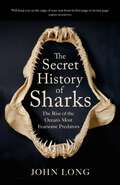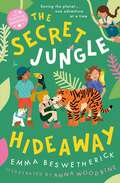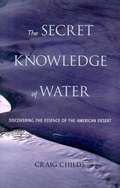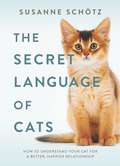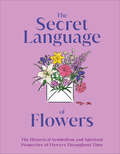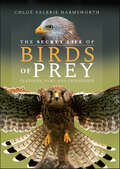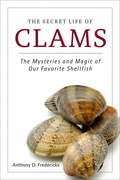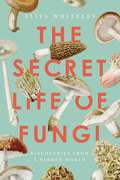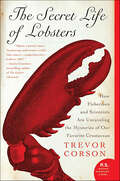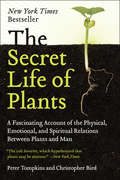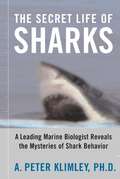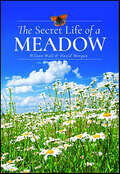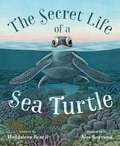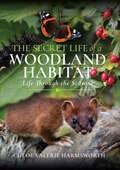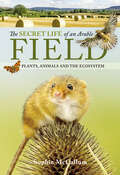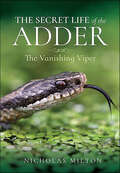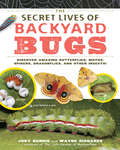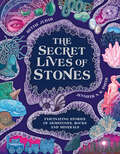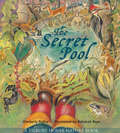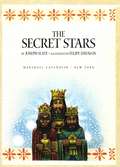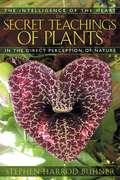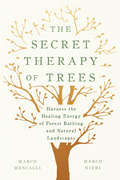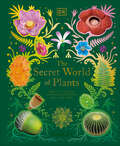- Table View
- List View
The Secret History of Sharks: The Rise of the Ocean's Most Fearsome Predators
by John Long'Will keep you on the edge of your seat from its first page to its last page' -Jared Diamond, Pulitzer Prize-winning author of Guns, Germs, and SteelFrom ancient megalodons to fearsome Great Whites, this book tells the complete, untold story of how sharks emerged as Earth's ultimate survivors, by world-leading paleontologist John Long.Sharks have been fighting for their lives for 500 million years and today are under dire threat. They are the longest-surviving vertebrate on Earth, outlasting multiple mass extinction events that decimated life on the planet. But how did they thrive for so long? By developing superpower-like abilities that allowed them to ascend to the top of the oceanic food chain. John Long, who for decades has been on the cutting edge of shark research, weaves a thrilling story of sharks' unparalleled reign. The Secret History of Sharks showcases the global search to discover sharks' largely unknown evolution, led by Long and dozens of other extraordinary scientists. As the tale unfolds, Long introduces an enormous range of astonishing organisms: a thirty-foot-long shark with a deadly saw blade of jagged teeth protruding from its lower jaws and bizarre sharks fossilized while in their mating ritual. With insights into the threats to sharks today, how they contribute to medical advances, and the lessons they can teach us about our own survival, The Secret History of Sharks is a riveting look at scientific discovery with ramifications far beyond the ocean.'This book is the work of a master scientist and storyteller. It will make you see sharks in a new way: not as blood-thirsty monsters that we should fear, but as nature's ultimate survivors' - Steve Brusatte, New York Times bestselling author of The Rise and Fall of the Dinosaurs'Readers will want to sink their teeth into this' - Publishers Weekly'Thoroughly researched and wonderfully narrated, The Secret History of Sharks makes a convincing case that the story of sharks is nothing less than the story of life on Earth. Highly recommended!' - Nate Blakeslee, New York Times bestselling author of American Wolf
The Secret Jungle Hideaway: Playdate Adventures
by Emma Beswetherick&“Guaranteed free of unicorns and princesses, it&’s fun, empowering fiction for 5-8 year olds.&” David Nicholls, author of One Day &“Every young girl should read this series!&” Amanda Holden Join Katy, Cassie, Zia and their new friend Luca on an amazing adventure as they work together to save the planet… Katy has adopted a Sumatran tiger – the most endangered tiger in the world- and she&’d love to go on an adventure to meet her. While on a playdate, Luca&’s garden magically transforms into the Sumatran jungle. But no matter how hard they all look, there&’s no sign of the tiger anywhere. As they navigate river rapids and have a close encounter with a venomous snake, Luca and the girls discover the threats to endangered species. Can the four friends and Thunder help find the last female Sumatran tiger?
The Secret Knowledge of Water: Discovering the Essence of the American Desert
by Craig ChildsA naturalist and explorer finds water holes, storms, floods and fascinating life forms in the Arizona desert and Grand Canyon.
The Secret Language of Cats: How to Understand Your Cat for a Better, Happier Relationship
by Susanne SchötzHave you ever wondered what your cat is saying? Cats do not meow randomly, nor do they growl or hiss because they have nothing better to do. Cat sounds have a purpose, and they can carry important messages, whether for us or other cats.Susanne Schötz is hard at work on breaking the cat code. She is a professor at Lund University in Sweden, where a long-standing research program is proving that cats do actually use vocal communication—with each other and with their human caretakers. Understanding the vocal strategies used in human-cat communication will have profound implications for how we communicate with our pets, and has the potential to improve the relationship between animals and humans within several fields, including animal therapy, veterinary medicine and animal sheltering.In The Secret Language of Cats, Schötz offers a crash course in the phonetic study of cat sounds. She introduces us to the full range of feline vocalizations and explains what they can mean in different situations, and she gives practical tips to help us understand our cats better.
The Secret Language of Flowers: The Historical Symbolism And Spiritual Properties Of Flowers Throughout Time (DK Secret Histories)
by DKDiscover the uses and symbolic meanings of flowers over the centuries and across the globe.Flowers have been depicted as objects of beauty and wonder in countless paintings and poems, exchanged as tokens of love and affection, and displayed as symbols of both celebration and remembrance – &“saying it with flowers&” is truly part of the human experience. But how does the significance of flowers vary across cultures and at different points in history? And what makes certain flowers special?The Secret Language of Flowers explores the meaning of more than 85 flowers, tracing their history as symbols and charting their role in folklore and mythology around the world. This fascinating book on flowers can help you to:- Unlock the meaning of flowers throughout history – from early peoples to the 19th century.- Discover the Victorian language of flowers popular in the US, UK, and Europe.- Gain insight into folklore and mythology in relation to different flowers.- Uncover what flowers mean in various cultures around the world. - Uncover traditional medicinal uses of plants, such as aloe, which is used to treat burns.Uncover the rich and fascinating histories of individual flowers – the sunflower, for example, which was regarded by the Aztecs as a symbol of war, but became a symbol of devotion in 19th-century painting due to the fact that it &“turns its head&” to follow the sun. Learn about the function of flowers in society, from the practical to the playful – flowers have been used as remedies and tonics – tea tree and coneflower (or echinacea), for example – as well as as a means of sending cryptic messages to lovers and friends.The Secret Language of Flowers is an entertaining guide to the rich stories that lie beyond the seductive aromas and dazzling beauty of flowers of all kinds. Each flower featured throughout the book is arranged by season, from the first snowdrops and primroses of spring, the glorious roses of summer, the stunning fuchsias and dahlias of autumn to the holly and poinsettia of the winter months, there&’s a flower for everyone to fall in love with. At DK, we believe in the power of discovery: So why stop there? If you like The Secret Language of Flowers, then why not try Great Loves which celebrates some of the most famous romances in history, or Lost Masterpieces to discover extraordinary stories behind the world's missing works of art.
The Secret Life of Birds of Prey: Feathers, Fury and Friendship
by Chloé Valerie HarmsworthEnter the fascinating world of the UK’s birds of prey. These noble hunters, with their remarkable flying skills, good looks and mysterious ways, are amongst our most attractive and interesting wildlife. They are some of the most enigmatic and rare species too, and this book will reveal them to you. Learn about the falcons, hawks, kites, osprey and eagles that grace our skies and landscape – from their impact on our culture in past and recent times, their value and uses in falconry, the history of their persecution and decline at the hands of humans, to their return to the UK through our reintroduction and conservation efforts. Admire their beauty up close with gorgeous photography and take an extraordinary peek into their secretive world. Be inspired by the moving words of people across the UK, who have described their thrilling, first-hand encounters, and discover where you can ethically experience these birds for yourself, to form an enduring connection with nature and make memories that will last a lifetime. This accessible and inspiring guide will help you to uncover the details of the habits, habitat, behaviour and diet (and much more) of our UK birds of prey, and show you how they bring delight and magic into our lives.
The Secret Life of Clams: The Mysteries and Magic of Our Favorite Shellfish
by Anthony D. FredericksGet up close and personal with an amazing creature that has invaded our lexicon as well as our restaurants.It breathes with tubes, it has no head or brain, it feeds through a filter, and it is the source of dozens of familiar proverbs ("happy as a clam!"). Clams, it turns out, have been worshipped (by the Moche people of ancient Peru), used as money (by the Algonquin Indians), and consumed by people for thousands of years. Yet The Secret Life of Clams is the first adult trade book to deal exclusively with this gastronomic treat that is more complex than its simple two shells might reveal. The Secret Life of Clams features compelling insights, captivating biology, wry observations, and up-to-the-minute natural history that will keep readers engaged and enthralled.Written by award-winning science author Anthony D. Fredericks, The Secret Life of Clams includes a comfortable infusion of humor, up-to-date research, fascinating individuals (scientists and laypeople alike), and the awe of a fellow explorer as he guides readers on a journey of wonder and adventure. Along with an appreciation for oceanic creatures, this is a guidebook for armchair marine biologists everywhere who seek amazing discoveries in concert with compelling narration.
The Secret Life of Fungi
by Aliya WhiteleyFungi are unlike any other living thing—they almost magically unique. Welcome to this astonishing world. . . Fungi can appear anywhere, from desert dunes to frozen tundra. They can invade our bodies and live between our toes or our floorboards. They are unwelcome intruders or vastly expensive treats, and symbols of both death and eternal life. But despite their familiar presence, there's still much to learn about the eruption, growth, and decay of their secret, interconnected, world. Aliya Whiteley has always been in love with fungi—from her childhood taking blurry photographs of strange fungal eruptions on Exmoor to a career as a writer inspired by their surreal and alien beauty. This love for fungi is a love for life, from single-cell spores to the largest living organism on the planet; a story stretching from Aliya's lawn into orbit and back again via every continent. From fields, feasts and fairy rings to death caps, puffballs and ambrosia beetles, this is an intoxicating journey into the life of extraordinary organism, one that we have barely begun to understand.
The Secret Life of Lobsters: How Fishermen and Scientists Are Unraveling the Mysteries of Our Favorite Crustacean
by Trevor Corson“Lobster is served three ways in this fascinating book: by fisherman, scientist and the crustaceans themselves. . . . Corson, who worked aboard commercial lobster boats for two years, weaves together these three worlds. The human worlds are surely interesting; but they can’t top the lobster life on the ocean floor.” — Washington PostIn this intimate portrait of an island lobstering community and an eccentric band of renegade biologists, journalist Trevor Corson escorts the reader onto the slippery decks of fishing boats, through danger-filled scuba dives, and deep into the churning currents of the Gulf of Maine to learn about the secret undersea lives of lobsters.This P.S. edition features an extra 16 pages of insights into the book, including author interviews, recommended reading, and more.
The Secret Life of Plants
by Peter Tompkins Christopher BirdChapter after chapter relates a multitude of discoveries from plant research around the world that demonstrate how plants grow, metabolize, and communicate not only within their own structure, but with all other life forms. Some researchers have used polygraph instruments connected to leaf surfaces to observe responses through electro-magnetic activity to various stimuli such as: raucous, loud music compared with mellow, harmonious music. The results are always the same: plants react favorably to mellow music while continuous raucous sounds can actually kill them. Even more amazingly, perhaps, is that plants accurately react to good or bad thoughts directed at them or other biological life forms and even at great distances.
The Secret Life of Plants: A Fascinating Account of the Physical, Emotional, and Spiritual Relations Between Plants and Man
by Peter Tompkins Christopher BirdThe world of plants and its relation to mankind as revealed by the latest scientific discoveries. "Plenty of hard facts and astounding scientific and practical lore."--Newsweek
The Secret Life of Sharks: A Leading Marine Biologist Reveals the Mysteries o
by A. Peter KlimleyMarine biologist Pete Klimley swims with the sharks. He was one of the first scientists to free-dive among sharks, and he has spent nearly thirty years studying shark behavior, sometimes swimming in schools of several hundred sharks. From his firsthand observations he has learned that sharks are not the vicious man-eaters that we imagine, but fascinating animals with complex behaviors.Most people who think of sharks at all think immediately of great white sharks. But there are more than four hundred species of shark. Dr. Klimley has studied several species, most notably the great white and the hammerhead. (He describes the great white as the athlete among sharks, and the hammerhead as the Ph.D. of the shark world.) In The Secret Life of Sharks Dr. Klimley reveals the significant discoveries he made about hammerhead navigation and great white eating habits. By studying hammerheads gathered around underwater seamounts, Dr. Klimley learned that hammerheads rely on sophisticated tracking of ocean-floor magnetism to navigate. His long-term study of great white sharks off the California coast demonstrated that these huge sharks prefer to eat seals and sea lions because of the energy contained in their fatty bodies. They are selective eaters, not the man-eaters we expect, and they sometimes go weeks between meals. But Dr. Klimley did observe a ritualized behavior that great whites practice in order to avoid deadly disputes over prey that one shark has captured and another wants.Although we have learned a great deal about shark behavior, says Dr. Klimley, there is much that we do not know. Unfortunately we are destroying these magnificent creatures of the deep through overfishing and degradation of the oceans. Already some populations of sharks have declined steeply.Vividly written by one of the foremost authorities on sharks, The Secret Life of Sharks is a fascinating account of some of the world's most magnificent animals.
The Secret Life of a Meadow
by David Morgan Wilson WallGlorious flower meadows were part of our life force for 2000 years or more before we swept them away last century on the altar of progress. Is there to be no more drinking from their font of well being? This book says not. Lavishly illustrated, it describes their history and, from the few remaining examples, it shows us how beautiful they are, how rich in plants and animals. It coaches us in their creation, even in small gardens, or their restoration in larger fields. It tells of the extraordinary lives of even the most ordinary denizens, little secrets that make the meadow's world go around and the convoluted links between the many plants and animals that keep everything in balance. Their stories are woven, season-by-season, into a year in the life of two meadows, a small, garden meadow and a larger old paddock. We hear of birds that plant trees, bacteria that become plant organelles, plants that drink from other plants, plants that fool or poison insects and insects that turn the tables, ants that foster butterflies, mice that navigate by compass, snails that house bees and how all of these connections, together with the flow of energy and nutrients, result in a healthy ecosystem. The book even suggests how adults and children alike can see these things for themselves. So, read this book and help your local green space to become a meadow and revel in it.
The Secret Life of a Sea Turtle
by Maddalena BearziFollow the captivating yet perilous life of one sea turtle in this dazzling nonfiction tale by the co-founder of the Ocean Conservation Society, perfect for fans of Jason Chin's ISLAND.On a beach at the Ría Lagartos nature reserve in Mexico, a sea turtle is born.Newly hatched into a big world, she breaks out of an egg buried in the sand. Now, her journey begins. To reach the ocean she must avoid predatory opossums, crabs, and raccoons -- many of her siblings will not make it. But our sea turtle does, and when she finally dives beneath the blue sea, she’ll travel for thousands of miles on a beautiful and pulse-pounding adventure.Brilliant, informative, and compelling, The Secret Life of a Sea Turtle is a sweeping nonfiction tale following one turtle’s extraordinary life from hatchling to adulthood, written by sea turtle expert and activist Maddalena Bearzi, and illustrated by rising star Alex Boersma.
The Secret Life of a Woodland Habitat: Life Through the Seasons
by Chloé Valerie HarmsworthDelve deep into the trees and find wonder in our UK woodlands. Step back from the pressures of everyday life and reconnect with nature and its mindful magic with this absorbing and engaging guide. Learn what you can see at different times of the year and recognize the stunning trees, flowers and plants, multi-hued birds and insects, and mysterious mammals that call these habitats home. Soon you will be marveling at rutting deer, soaking up the view of beautiful bluebells, and entering the world of bumbling badgers and fantastic foxes, while also enjoying the rapturous sound of glorious birdsong. Press pause on your modern worries and go back to your ancestors’ roots by foraging for nuts and berries. Become aware of the signs that indicate one season transforming into another. Search for fairytale mushrooms and at the same time understand why they are essential to our environment. Discover the science, history and folklore associated with the oak, ash and birch. On your seasonal adventures through our enigmatic woodlands, be humbled by their importance to our interconnected ecosystem, and be inspired to protect these precious places for the betterment of the world. This accessible guide, with its attractive and original photos, will help you to build an everlasting bond with your local wildlife and woodlands, thus enriching your well-being and life.
The Secret Life of an Arable Field: Plants, Animals and the Ecosystem
by Sophie McCallumThe Field looks at the eco-system of an arable field, complete with photographs from crops, trees, hedgerows and wildflowers, to the wide variety of animals, farmland birds, insects, butterflies and moths that they support; and how they depend on each other; and are all vital for the wonderful environment we need to thrive and enjoy. The book focuses on the relationship between these key species, how they work together and interact with their environment in order to survive. It is about the eco-system and how they all link together, and how every species, no matter how seemingly insignificant, plays a vital part in the food-chain and ultimate survival of all species. For every species referred there is a photograph detailing it, with over 120 color images throughout the book. The animals and birds that live within this habitat are reported on and the insects; including detailed analysis of bumblebees, honeybees and ants, as well as more hidden species such as the earthworm, are described in their role in life, with in-depth facts and photos. Wildlife, such as badgers, muntjacs, hedgehogs and fallow deer and their habits are detailed, along with birds that survive on farmland and are now sadly becoming rare. Included in this range are corn buntings, skylarks, goldfinches, kestrels, yellow wagtails and jackdaws, although there are many more. The main aim of this book is to give a detailed description of the private life of these creatures and show how they depend upon and work together in harmony, creating the environment that we are so adeptly eradicating. The Government have set out a package of reforms to deliver 300,000 new homes a year by the mid-2020s. Our havens of nature are being destroyed and this book will examine, with photographs and text, what really makes the field a special place, both for wildlife and humans alike.
The Secret Life of the Adder: The Vanishing Viper
by Nicholas MiltonIn 2019 the most comprehensive survey ever of adders was published. According to ‘Make the Adder Count’ the species will disappear from most of Britain in the next 15-20 years unless we take action now to save it. But despite being a priority conservation species under the Biodiversity Action Plan, not a single nature reserve in Britain has been specifically designated to protect it. Throughout our history we have systematically persecuted the adder over generations because it is Britain’s only venomous snake. Now the adder population is in dire straits, its rapidly declining numbers occurring on increasingly small, isolated and fragmented sites. According to Make the Adder Count 90% of the sites where it still occurs have 10 or less adult snakes and are now considered to be very vulnerable to local extinction. Despite the adder population being in dire straits, it is still not too late to save it if we act now. This book contains a 10 point adder action plan which if implemented could help to restore the adder to its former range across Britain. Using many unique photographs of the species published for the first time, it also contains a history of the adder and reveals its secret life which has made it the most successful snake in the world. With a foreword by Iolo Williams, the BBC Springwatch presenter, this book is a story of our times, one which typifies the age of extinction through which we are all living and are all responsible.
The Secret Lives of Backyard Bugs: Discover Amazing Butterflies, Moths, Spiders, Dragonflies, and Other Insects!
by Judy Burris Wayne RichardsThis fun book will have kids bugging out! Explore the fascinating miniature world of spiders, beetles, grasshoppers, butterflies, and more as stunning photography combines with expert information to create an up-close-and-personal look at the hidden lives of these tiny backyard residents. Watch each creature progress through different life stages as they eat, grow, and learn in a natural setting. Surprising and captivating, this one-of-a-kind introduction to the crawlers and flyers just outside the door is a delight for nature lovers of all ages.
The Secret Lives of Stones: Fascinating stories of gemstones, rocks and minerals
by Hettie JudahUnearth the secret lives of stones in this dazzling cabinet of curiosities exploring the fascinating stories of 25 spectacular rocks and gems.Delve into a world of gemstones, rocks and minerals to discover the golden amber that once dripped as liquid resin in prehistoric forests, capturing ancient creatures for eternity. Find out how deep-blue lapis lazuli has been prized for thousands of years and used to make a rare paint pigment by artists during the Renaissance and discover the amazing magnetic properties of lodestone and how this helped Chinese sailors navigate the oceans over 2,000 years ago.Covering geology, history, myth and folklore, renowned art-critic Hettie Judah brings the stories of stones to life, with beautiful illustrations by award-winning artist Jennifer N R Smith. All stones have a story to tell - - stories that can teach us about the history of the planet and our own human past.
The Secret Pool (Tilbury House Nature Book #0)
by Rebekah Raye Kimberley Ridley<P>You might walk right by a vernal pool and not notice it. Often mistaken for mere puddles in the woods, vernal pools are the source of life for many interesting creatures. If you look carefully, you can find them--and be amazed! <P>These secret pools form every year when low places on the forest floor fill up with rain and melted snow. They soon become home to hatching wood frogs, spotted salamanders, and fairy shrimp. Even in late summer and fall, when many vernal pools have shrunk to mud holes, creatures such as turtles and snakes rely on them for shelter and food. <P>The Secret Pool introduces young readers to the wonders right underfoot as the voice of a vernal pool shares its secrets through the seasons, and sidebars provide fun facts on its inhabitants and the crucial role these small, often overlooked wetlands play in maintaining a healthy environment. <P><b>Winner of the 2018 Riverby Award</b>
The Secret Stars
by Joseph SlateIn New Mexico on a rainy, icy Night of the Three Kings, Sila and Pepe worry that the kings will not be able to use the stars to navigate, so their grandmother takes them on a magical journey to see the secret stars all around them.
The Secret Teachings of Plants: The Intelligence of the Heart in the Direct Perception of Nature
by Stephen Harrod BuhnerReveals the use of direct perception in understanding Nature, medicinal plants, and the healing of human disease• Explores the techniques used by indigenous and Western peoples to learn directly from the plants themselves, including those of Henry David Thoreau, Goethe, and Masanobu Fukuoka, author of The One Straw Revolution• Contains leading-edge information on the heart as an organ of perceptionAll ancient and indigenous peoples insisted their knowledge of plant medicines came from the plants themselves and not through trial-and-error experimentation. Less well known is that many Western peoples made this same assertion. There are, in fact, two modes of cognition available to all human beings--the brain-based linear and the heart-based holistic. The heart-centered mode of perception can be exceptionally accurate and detailed in its information gathering capacities if, as indigenous and ancient peoples asserted, the heart’s ability as an organ of perception is developed.Author Stephen Harrod Buhner explores this second mode of perception in great detail through the work of numerous remarkable people, from Luther Burbank, who cultivated the majority of food plants we now take for granted, to the great German poet and scientist Goethe and his studies of the metamorphosis of plants. Buhner explores the commonalities among these individuals in their approach to learning from the plant world and outlines the specific steps involved. Readers will gain the tools necessary to gather information directly from the heart of Nature, to directly learn the medicinal uses of plants, to engage in diagnosis of disease, and to understand the soul-making process that such deep connection with the world engenders.
The Secret Therapy of Trees: Harness the Healing Energy of Forest Bathing and Natural Landscapes
by Marco Mencagli Marco NieriIn The Secret Therapy of Trees, Marco Mencagli and Marco Nieri explore the relationship between plants and organisms, and illustrate how to benefit from nature's positive impact on our psychological and physical well-being.Our connection to nature is deeply rooted in the history of our evolution. And yet, we have less contact with green space now than ever, and our stress and anxiety levels are at an all-time high. The Secret Therapy of Trees helps us rediscover the restorative value of our natural environment and presents the science behind green therapies like forest bathing and bioenergetic landscapes, explaining which are the most effective and how to put them into practice to achieve the best possible results. Studies have shown that increased exposure to green space can result in a regulated heartbeat, lowered blood pressure, reduced aggressiveness, improved memory skills and cognitive function, and a healthier immune system. Just one visit to a forest can bring positive effects (hint: monoterpenes, the natural essential oils in plants, have numerous positive effects on health), and even a mindful walk through a semi natural park can alleviate physical and psychological stress. With multiple studies backing its findings and thorough explanations for each technique, The Secret Therapy of Trees is a treasure trove of tips on how to harness the regenerative power of plants and reconnect with our planet's natural spaces, bringing us health and happiness. You'll also discover:* Which plants purify the environment at home and in the office* The benefits of negative ions and where to find them* How to recharge through contact with trees
The Secret World of Caves (Fountas & Pinnell LLI Gold #Level R)
by Will HurdAn underground wonderland. You might think caves are dark, damp, and frightening, but cavers all over the world know that caves are full of wonderful secrets and bizarre sights.
The Secret World of Plants: Tales of More Than 100 Remarkable Flowers, Trees, and Seeds (DK Treasures)
by Ben HoareA timeless treasury of more than 100 stories from the incredible kingdom of plants, told by author and nature expert Ben Hoare.Plants are found almost everywhere on Earth, but to many people their lives are a mystery. Learn how seagrass flowers underwater, how the Venus flytrap counts to make sure it catches its prey, and why some tulips used to cost more than a house! This fascinating book for kids explores the vast plant kingdom and explains how plants work, as well as the weird and wonderful relationships they have with animals.Children can discover the secrets of more than 100 amazing plants in this treasury of fascinating flora, as well as the essentials of plant science, including photosynthesis, pollination, and germination. Each species is shown with remarkable photography and beautiful illustrations, all brought to life by Ben Hoare&’s writing, filled with charm and infectious enthusiasm. This nature book for children ages 7+ features:- An eye-catching holographic cover, gilded edges, and stunning photography and illustrations, making it the perfect gift - A wide range of incredible plants and trees from all around the world- Illustrated diagrams to support definitions of different types of plants - Introductory reference pages that explain key topics such as photosynthesisThis book is a must for any child interested in the natural world and the plants that grow in it. Plants provide us with food, fuel, and medicine, and without them, life as we know it would not exist. From orchids that grow vanilla pods to leaves that look like stones, and from bamboo that can be made into clothes to moss that soaks up vast amounts of carbon dioxide, plants shape our world in an endless variety of ways.
